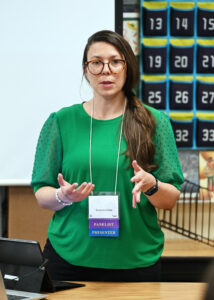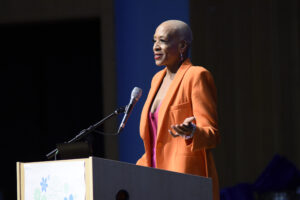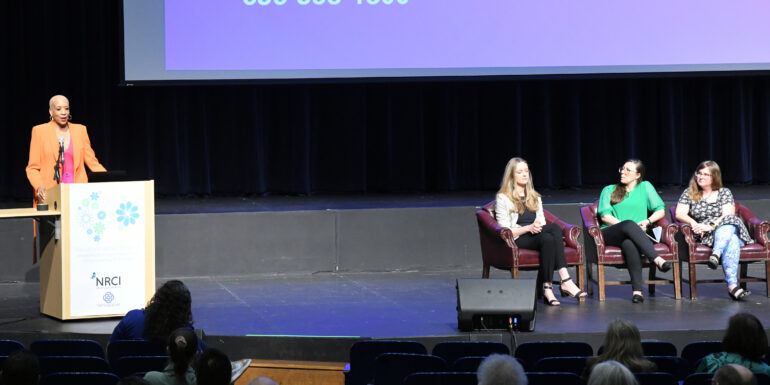Perhaps no topic better demonstrates the value of mental health education than neurodiversity, an umbrella for a wide range of conditions including autism, ADHD, OCD, and dyslexia. The nature of symptoms and behaviors for those who identify as neurodivergent are varied, and the resulting lack of clarity among the general population often leads to misunderstandings that invite stigma.
On May 17, the Naomi Ruth Cohen Institute for Mental Health Education’s 23rd Annual Community Mental Health Conference convened at Evanston Township High School on this year’s theme: Neurodiverse Brains: Understanding Differences, Empowering Potential. NRCI co-founder Larry Cohen confessed in his opening remarks that, when the institute’s executive director Tracy Levine suggested neurological divergence as the topic for the conference, “I really didn’t know what she was talking about.”
“I mean that different brains think differently, and we have to recognize that fact and understand how to help treatment and provide support,” Levine replied.
The panel moderator, Natalie LaDuke, Ph.D., a licensed clinical psychologist and nationally certified school psychologist, says, “Diversity in the way we think, in the way we learn, manage our emotions, and socialize is not only normal, but it’s valuable. Today is all about learning how to see those differences, celebrate those differences, and empower potential for ourselves and the neurodiverse people in our lives.”
Throughout the history of the conference, the organizers have always been careful to include on the panel of presenters someone who has lived with or directly experienced the mental health issue up for discussion. This year each of the presenters has.
Words Matter
Samantha Kolkey, LCSW, the director of programs and services at the Center for Independent Futures in Evanston, was diagnosed with ADHD in college. She received treatment and medication that, she says, “transformed how I interacted with the world and allowed me to achieve a potential that I knew I had but wasn’t quite able to harness.” Her personal experience inspired her to empower disabled individuals and their families and to bring a neurodiversity approach to all areas of her personal and professional lives.
Kolkey’s talk focused on the history of neurodiversity, defining terms, and the paradigm shift that led to current approaches to neurodiversity in the clinical realm as well as in mental health education.

“Neurodiversity is another form of human diversity,” she says. “It’s a biological fact, part of human evolution, and natural and valuable.” The term, which suggests diversity among minds, was first used in 1996 within autistic community online forums. It entered the clinical field in a 1998 thesis by Australian sociologist Judy Singer. It was popularized in a 1998 article in The Atlantic magazine by Harvey Blume, “Neurodiversity: On the underpinnings of geekdom.”
Given the evolving understanding of neurodiversity, Kolkey stresses that using precise language is important. “If a person is neurodivergent, it means they deviate from the neuronormative, or neurotypical, majority,” she says. Additionally, she explains, “Individuals are neurodivergent. Only groups of people can be described as neurodiverse.”
Kolkey also sees an important shift in in language that reflects a change in the perceptions of neurodivergent people. “You often hear with autistic folks that they’re low functioning or high functioning, but disability is far more nuanced than that,” she says. “Ultimately, there’s no normal or right style of human mind any more than there’s one normal or right ethnicity, gender, or culture. Therefore, no one type of brain function is right or best. Ideal neurocognitive function is a social construct.”
A Wolf Among Foxes
As therapist and author Jennifer Gerlach, LCSW, began her presentation, a slide on the screen in the auditorium showed a picture of her as a preteen standing with her father beside a snowman. Gerlach is wearing a short-sleeved shirt. “That picture was a victory,” she explains, “because I really hated the feeling of a coat. I hated that a lot more than cold or pain.” Her parents relented and let her go outside with bare arms. This episode is reflective of the ways in which neurodivergent people may struggle with convention in ways that are mysterious to others.
“I was probably neurodivergent since I was born, but they gave it all kinds of different names,” Gerlach says. “Some people called it ‘weird,’ some people called it ‘different,’ some people called it ADHD, autism, a whole bunch of different things.”
“To me, neurodivergent means having a little bit of a different brain style,” she says. “It’s like beinga wolf in a world where everybody’s a fox, and you’re supposed to blend in and just know all these fox rules that you’ve never been taught.” This struggle to conform academically and socially can often have profound emotional and psychological consequences for neurodivergent individuals.
Gerlach was placed in social skills groups in which the facilitators attempted to teach her to modulateher voice and make eye contact. “I just thought I wasn’t good,” she recalls. “If I was good, I’dhave friends, and I’d get good grades and all that, and I wouldn’t be in trouble all the time and not know why.”

Like many others, Gerlach found acceptance and community within the neurodiversity movement as well as answers to her questions about why she struggled to fit in. As educators and clinicians have been slow in understanding the complexities of neurodivergent minds, these individuals have found answers and support from conversations they have generated among themselves. “What it’s meant to me is realizing that I’m not a broken fox,” she says. “I am a wolf, and it’s OK to be a wolf.”
Creating the Support You Need
Debra Vines, founder and CEO of The Answer Inc. Autism Awareness and Support Agency, is the mother of a 37-year-old son with autism. Jason was born premature at 24 weeks and weighed less than 3 pounds. Doctors warned Vines and her husband that there would be challenges. At first, Jason’s development seemed normal, but then that changed dramatically. “He was not making eye contact,” Vine says. “He could hardly crawl. It was like his motor skills just went away.”

Vines said she consulted at least five doctors. The last one told her that her son had autism. In 1988, the diagnosis rate for autism was one in 1,000, Vines said. Her only experience with the condition was the film “Rain Man,” which depicted an adult savant. The most common piece of advice she read in the literature she consulted was to find a support group, but at the time, there were none to be found on Chicago’s underserved West Side, so she had to travel to the affluent suburbs north of the city. She walked from the train through a parking lot full of luxury vehicles to find herself the only Black person in the room. “The women were talking about technological supports for their children, she says, “and I just wanted to have money to pay my copay.”
When Jason was 12, Vines devoted herself to activism. She founded The Answer Inc. in 2007 to provide resources, education, recreation, advocacy, social skills, and workforce development for families living with autism and other developmental disabilities.
“I just started listening to the needs of the families touched by autism and my own personal needs as to how to increase The Answer’s services,” Vines says. The answer has served more than 4,000 children and adults. In 2022, Vines was recognized as a CNN Top 10 Hero for her work. “I can say right now that Jason is thriving and a lot of our participants in our program are doing absolutely amazing,” Vines says.
The Conversation Continues
Discussions continued in three rounds of nearly 20 breakout sessions devoted to issues surrounding neurodiversity in children and adults in school, clinical, and workplace environments. Since the first was held nearly a quarter century ago, the focus of the annual conference has been on community, inviting the public into discussions about mental health issues that affect them, their families, and their friends and neighbors.
Additionally, mental health professionals and educators received continuing education and professional development credit for attending sessions, including ADHD and Neurodiversity, Embracing Neurodiversity: Cultivating Inclusive Workplaces and Services, and Talk Saves Lives: Suicide Prevention Best Practices and Research for Neurodiverse Individuals.
A licensed clinical professional counselor who was attending her first NRCI conference said she found the panel discussion and breakout sessions helpful and informative. “I came with questions, and they are all subsequently being answered,” she said. “I look forward to attending the conference in the future.”

